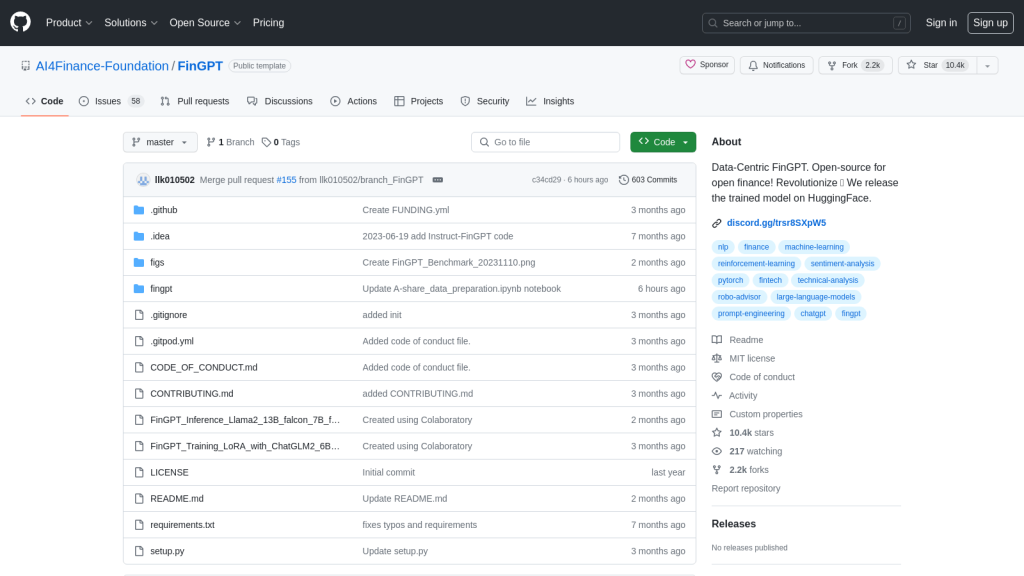What is FinGPT?
FinGPT is a full-suite platform developed by FinNLP for individuals and institutions that want to put Large Language Models and NLP into practice within the financial space. It allows for end-to-end pipelines when it comes to training and fine-tuning LLMs for financial needs.
Key Features & Benefits of FinGPT
FinGPT has a set of features and benefits helpful in different types of users. Key features include:
-
LLM Training:
FinGPT has strong tools for training large language models with the best fit for financial data processing and analysis. -
NLP Fine-tuning:
It allows fine-tuning of NLP models on the nuances of financial language and context. -
Finance Integration:
Designed with financial applications in mind, FinGPT seamlessly interacts with any current workflows or finance-related systems.
Using FinGPT can bring a huge improvement in the accuracy of financial forecasting, smooth integration to automate most of the financial workflows, and unlock deep insights from the financial data using the latest NLP technology.
Use Cases and Applications of FinGPT
FinGPT could be used in several ways for different use cases within the vertical of finance. A few examples are:
-
Financial workflow management automation:
The ability of FinGPT to automate various parts of financial workflow management-ranging from data entry to report generation-reduces manual effort and thereby enhances efficiency. -
Fine-tuning of language models for finance:
Fine-tuning of language models on financial text supports better understanding and processing of complex financial documents for decision-making.
It finds applications in banking, investment firms, insurance, and other areas where there is heavy reliance on financial data and documentation. Case studies conducted have shown that there is a sea change in operational efficiency and data accuracy after the implementation of FinGPT.
How to Use FinGPT
Following are the ways any entity can get started with the use of FinGPT:
-
Sign Up:
One signs up on the online platform of FinGPT. -
Setup:
The next would be to set up the environment and upload the financial data required for the process. -
Train Models:
Train large language models using the tools on your specific financial datasets. Fine-tune the models to better understand and process your financial data. Seamlessly integrate the different models that are trained into your current financial systems and workflows.
Refreshing your models from time to time with new data and always monitoring their performances is a best practice for the best results. The user interface is designed intuitively, with features that walk you through each step of the way.
How FinGPT Works
FinGPT uses advanced algorithms and models specifically built for financial applications. FinGPT is developed on state-of-the-art large language models, which are fine-tuned for processing and analyzing financial data.
This generally involves the importation of financial datasets, training the models, fine-tuning them on specific financial tasks, and integrating them into existing workflows. This way, such models will be relatively accurate, efficient, and fine-tuned for certain needs within the finance industry.
Pros and Cons of FinGPT
Following are some of the pros of using FinGPT:
-
High Accuracy:
The FinGPT models are trained and fine-tuned to give highly accurate financial predictions and analyses. -
Efficiency:
Automation of financial workflows saves time and reduces the likelihood of manual errors. -
Customization:
The ability to fine-tune models for specific financial needs and contexts ensures a good fit.
On the other hand, some of the possible downsides are:
-
Complexity:
Model setup and fine-tuning can be complicated and sometimes require technical expertise. -
Cost:
The platform may have associated costs that could be expensive for smaller firms.
Overall, user feedback has generally been positive, with many praising the capabilities of the platform and its enhancements in efficiency.
Conclusion about FinGPT
FinGPT is a state-of-the-art tool for all those in the financial sector to make good utilization of their next-generation NLP and LLMs. It is fully featured, specifically oriented toward financial uses, which makes it a very valuable source. Of course, everything has its complications and costs, but with benefits like increased accuracy and efficiency, it is worth an investment. And, of course, with regular updates and improvement, even the future looks bright.
FinGPT FAQs
-
Q:
What are some examples of the financial data it can handle?
A:
Well, examples include text documents, reports, and statements-really, any form of financial data one could imagine. -
Q:
Does it take any technical expertise to use FinGPT?
A:
While useful, some technical knowledge is not required-the platform is well-structured and guides users in depth, with support provided. -
Q:
How often does a model need updating?
A:
Yes, models are best updated with new data on a regular basis to keep them accurate and fresh. -
Q:
Can FinGPT be integrated with any of the existing financial systems?
A:
Yes, FinGPT can be easily integrated with different already existing financial workflows or systems.
Having an Issue?
If you find any issue or problem, go through the troubleshooting tips and support to get you through the process.










